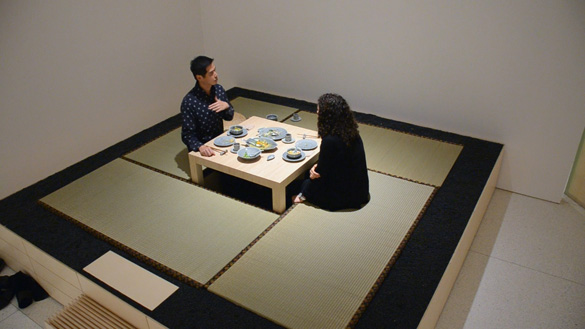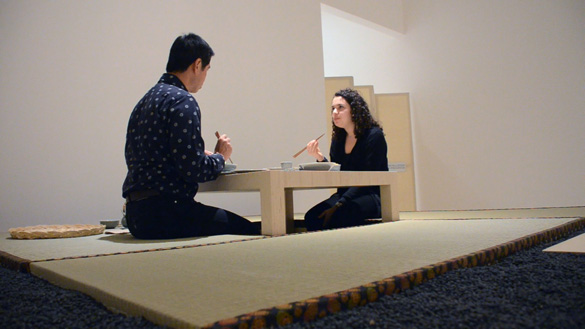Recently in Feast artists Category
Theaster Gates shows how creating intentional space for community can drive artistic discourse, through the construction, layout, and use of the Dorchester Projects house, home to the Soul Food Pavilion dinners.
Feast artists Marina Abramović, Sonja Alhäuser, Mary Ellen Carroll, Theaster Gates, Mella Jaarsma, Alison Knowles, Suzanne Lacy, Lee Mingwei, Laura Letinsky, Tom Marioni, Ana Prvacki, and Michael Rakowitz reflect on hospitality.
Mella Jaarsma: I Eat You Eat Me from Smart Museum of Art on Vimeo.
Staged previously in Bangkok, Jakarta, and Sweden, Mella Jaarsma's participatory project I Eat You Eat Me can currently be experienced in a two-person setting at the Smart Café. (Art history student James Levinsohn previously wrote about his experiences with the six-person version, and the video of that meal is currently on view in Feast.)
Here Jaarsma discusses the origins of the project in Indonesia, and the rules diners must abide by while participating. Intrigued? Our baristas will gladly furnish you with a wearable table throughout the run of Feast.
In 1996, Mary Ellen Carroll's Itinerant Gastronomy project began when the artist serendipitously acquired five hundred oysters, which were shared with friends and passers-by before a lower Manhattan storefront.
Since then, Carroll has staged meals on a construction site, in an art gallery, and on New York's High Line (pre-renovation) -- all with the intention of bringing people together for site-specific discussion and
food. In January of 2012, Open Outcry, the most recent iteration of Itinerant Gastronomy, commissioned for Feast, was staged in the Financial Gallery at CME Group, above the Chicago Board of Trade. Seated at a
custom-designed circular table able to be moved into various configurations -- a result of Carroll's collaboration with architect Simon Dance -- guests engaged in various ways with economics, art, and social justice shared food and conversation. With each of five subsequent courses came a new topic of discussion -- communication, commodity, policy, taste, and intention.
A collection of material from the history of Itinerant Gastronomy -- including transcripts, menus, photographs, a video of Open Outcry, and the specially designed seating used for its performance -- is on view with Feast through June 10.
At a time when reproducable visual culture dominates spheres of human communication, how does photography transform our relation to objects? In her recent still life work, Laura Letinsky has worked with images from food and lifestyle magazines, both confronting traditions of composition and engaging with the "substitute and fetish" magazine culture constitutes.
The MCA exhibition of Letinsky's photography is on view through April 17; her work is also featured in Feast, through June 10.
While we've been staging a wide variety of programming offering visitors the opportunity to join the feast, no event exemplifies the intimacy of the act of sharing food so much as Lee Mingwei's Dining Project.
Lee's specially-built platform, encapsulating a dinner table built for two, is on view to all who visit Feast, but a handful of guests have had the chance to enter into the arena and dine with artist himself. UChicago undergrad and Smart café attendant Dory Fox described her dinner with Lee in a blog post earlier this year.
Lee will be returning to Chicago to stage three additional dinners on April 30, May 1 and May 2. To enter for the chance to have a one-of-a-kind dining experience of your own, submit your name to the online drawing.
An open bar, and a lively crowd past closing time - are you at a gallery opening? A happy hour? Or simply enjoying beer with friends?
Describing his long-running salon, The Act of Drinking Beer With Friends Is The Highest Form of Art - staged throughout the world since 1970, always in accordance with specific guidelines - Tom Marioni quotes Benjamin Franklin: "Beer is proof that God loves us and wants us to be happy."
The popular Feast fixture returns this Thursday with special guest bartenders, members of the Chicago hip-hop collective BBU. Upcoming bartenders include poets and teaching artists from Young Chicago Authors and experimental theater collective The Neo-Futurists. Keep an eye to our Facebook events page for updates.
If you are visiting the Smart this spring, you may be greeted at the door with a spoon. A tradition of hospitality in Serbia, the offering of the strawberry preserve slatko is intended to sweeten your visit as well as your tongue - and it will indeed be very sweet, as our student staff's reactions demonstrate.
Ana Prvacki, creator of The Greeting Committee, thinks of the project not only as a gesture of welcome. "Hospitality, and the idea of host and hostage, are etymologically very close. You could be an overly eager host that makes the guest into a hostage. I think there are a lot of very dark sides to hospitality."
Experience it for yourself - slatko is being served up on select days throughout the run of Feast.

By Dory Fox
The performative nature of Lee Mingwei's The Dining Project rang a particularly strong chord for me as an employee of the Smart Museum, whose usual role is to welcome the museum's guests and to provide them with food. I spend hours each week serving guests in the Museum's café, while Mingwei was a visiting artist, creating a new project for the museum's exhibition. And yet, he welcomed me; he made me feel like a hosted guest. This role reversal called my attention to the way that our physical surroundings affect our social roles. However, through the establishment that Mingwei would be the host and I the guest, I also saw how deciding to take a new role can transform how we interact with our surroundings, and can de-familiarize a once familiar space.
One of my favorite parts of Mingwei's piece was the physical design of the table and seating area. When a person sits at a table in a restaurant, or in another person's home, they are exposed. A table acts to shield a person's body to an extent, but a seated individual, stagnant, casted to the shape of his chair, becomes an object on display, just like any other piece in a dining room or in a gallery.

However, I believe that Mingwei's design combated this feeling of display and exposure that one can feel while dining in an unfamiliar environment. I was very surprised when I approached the table, and Mingwei swung his legs around let them hang into a square recess beneath the table. Rather than sitting on chairs or on the ground, we were sitting on closed square of benches. The dining set was like a building, and our legs rested in its courtyard. The platform he had built transformed in my mind from a pedestal to a fortress, from a structure of display to one of protection. This scheme made me feel safe comfortable from the moment I sat down.
Mingwei had also filled the "courtyard" with black beans, which provided a massage for our socked feet when we sat at the table. I spent nearly the entire meal tracing circles in the beans with my feet, like a child playing in the sand at the beach. I thought the beans were a lighthearted and fanciful touch, which provided a constant sensory experience throughout the course of the meal. We are so used to the idea of hospitality through our sense of taste, but people rarely think of how hosts attend to the other senses of their guests. The black bean foot massage heightened my awareness of the importance of sensory comfort and pleasure in hospitality encounters. The significance of sharing a meal lies not only in sharing physical nourishment but also in sharing physical pleasure. I think that this allows for certain level of human recognition: your host or your guest, like you, has a human body that needs sustenance, and your host or guest, like you, has a human body that experiences pleasure.
Join the Feast: the artist will be back in Chicago to host three more one-on-one dinners in the Smart's galleries on April 30, May 1, and May 2. Guests will be chosen by lottery. To enter the drawing or to learn more about this and other participatory projects, visit smartmuseum.uchicago.edu/join-the-feast.
Above: Dory Fox and Lee Mingwei dining at the Smart. Photos by Steve Rosofsky.